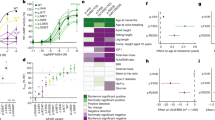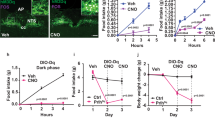Abstract
The melanocortin-4 receptor (MC4R) is critically involved in regulating energy balance, and obesity has been observed in mice with mutations in the gene for brain-derived neurotrophic factor (BDNF). Here we report that BDNF is expressed at high levels in the ventromedial hypothalamus (VMH) where its expression is regulated by nutritional state and by MC4R signaling. In addition, similar to MC4R mutants, mouse mutants that expresses the BDNF receptor TrkB at a quarter of the normal amount showed hyperphagia and excessive weight gain on higher-fat diets. Furthermore, BDNF infusion into the brain suppressed the hyperphagia and excessive weight gain observed on higher-fat diets in mice with deficient MC4R signaling. These results show that MC4R signaling controls BDNF expression in the VMH and support the hypothesis that BDNF is an important effector through which MC4R signaling controls energy balance.
This is a preview of subscription content, access via your institution
Access options
Subscribe to this journal
Receive 12 print issues and online access
$209.00 per year
only $17.42 per issue
Buy this article
- Purchase on Springer Link
- Instant access to full article PDF
Prices may be subject to local taxes which are calculated during checkout







Similar content being viewed by others
References
Huang, E.J. & Reichardt, L.F. Neurotrophins: roles in neuronal development and function. Annu. Rev. Neurosci. 24, 677–736 (2001).
Lyons, W.E. et al. Brain-derived neurotrophic factor–deficient mice develop aggressiveness and hyperphagia in conjunction with brain serotonergic abnormalities. Proc. Natl. Acad. Sci. USA 96, 15239–15244 (1999).
Kernie, S.G., Liebl, D.J. & Parada, L.F. BDNF regulates eating behavior and locomotor activity in mice. EMBO J. 19, 1290–1300 (2000).
Rios, M. et al. Conditional deletion of brain-derived neurotrophic factor in the postnatal brain leads to obesity and hyperactivity. Mol. Endocrinol. 15, 1748–1757 (2001).
Ono, M. et al. Brain-derived neurotrophic factor reduces blood glucose level in obese diabetic mice but not in normal mice. Biochem. Biophys. Res. Commun. 238, 633–637 (1997).
Nakagawa, T. et al. Brain-derived neurotrophic factor regulates glucose metabolism by modulating energy balance in diabetic mice. Diabetes 49, 436–444 (2000).
Nonomura, T. et al. Brain-derived neurotrophic factor regulates energy expenditure through the central nervous system in obese diabetic mice. Int. J. Exp. Diabetes Res. 2, 201–209 (2001).
Tsuchida, A. et al. Acute effects of brain-derived neurotrophic factor on energy expenditure in obese diabetic mice. Int. J. Obes. Relat. Metab. Disord. 25, 1286–1293 (2001).
Brooks, C.M., Lockwood, R.A. & Wiggins, M.L. A study of the effect of hypothalamic lesions on the eating habits of the albino rat. Am. J. Physiol. 147, 735–741 (1946).
Hetherington, A.W. & Ranson, S.W. The relation of various hypothalamic lesions to adiposity in the rat. J. Comp. Neurol. 76, 475–499 (1942).
Shimizu, N., Oomura, Y., Plata-Salaman, C.R. & Morimoto, M. Hyperphagia and obesity in rats with bilateral ibotenic acid–induced lesions of the ventromedial hypothalamic nucleus. Brain Res. 416, 153–156 (1987).
Friedman, J.M. & Halaas, J.L. Leptin and the regulation of body weight in mammals. Nature 395, 763–770 (1998).
Flier, J.S. & Maratos–Flier, E. Obesity and the hypothalamus: novel peptides for new pathways. Cell 92, 437–440 (1998).
Schwartz, M.W., Woods, S.C., Porte, D. Jr., Seeley, R.J. & Baskin, D.G. Central nervous system control of food intake. Nature 404, 661–671 (2000).
Elmquist, J.K., Elias, C.F. & Saper, C.B. From lesions to leptin: hypothalamic control of food intake and body weight. Neuron 22, 221–232 (1999).
Smith, A.I. & Funder, J.W. Proopiomelanocortin processing in the pituitary, central nervous system, and peripheral tissues. Endocr. Rev. 9, 159–179 (1988).
Baskin, D.G. et al. Insulin and leptin: dual adiposity signals to the brain for the regulation of food intake and body weight. Brain Res. 848, 114–123 (1999).
Batterham, R.L. et al. Gut hormone PYY(3–36) physiologically inhibits food intake. Nature 418, 650–654 (2002).
Heisler, L.K. et al. Activation of central melanocortin pathways by fenfluramine. Science 297, 609–611 (2002).
Benoit, S.C. et al. The catabolic action of insulin in the brain is mediated by melanocortins. J. Neurosci. 22, 9048–9052 (2002).
Cone, R.D. et al. The arcuate nucleus as a conduit for diverse signals relevant to energy homeostasis. Int. J. Obes. Relat. Metab. Disord. 25, S63–67 (2001).
Bultman, S.J., Michaud, E.J. & Woychik, R.P. Molecular characterization of the mouse agouti locus. Cell 71, 1195–1204 (1992).
Miller, M.W. et al. Cloning of the mouse agouti gene predicts a secreted protein ubiquitously expressed in mice carrying the lethal yellow mutation. Genes Dev. 7, 454–467 (1993).
Huszar, D. et al. Targeted disruption of the melanocortin-4 receptor results in obesity in mice. Cell 88, 131–141 (1997).
Chen, A.S. et al. Role of the melanocortin-4 receptor in metabolic rate and food intake in mice. Transgenic Res. 9, 145–154 (2000).
Lu, D. et al. Agouti protein is an antagonist of the melanocyte-stimulating hormone receptor. Nature 371, 799–802 (1994).
Butler, A.A. et al. Melanocortin-4 receptor is required for acute homeostatic responses to increased dietary fat. Nat. Neurosci. 4, 605–611 (2001).
Bennett, J.L., Zeiler, S.R. & Jones, K.R. Patterned expression of BDNF and NT–3 in the retina and anterior segment of the developing mammalian eye. Invest. Ophthalmol. Vis. Sci. 40, 2996–3005 (1999).
Barsh, G.S. & Schwartz, M.W. Genetic approaches to studying energy balance: perception and integration. Nat. Rev. Genet. 3, 589–600 (2002).
Xu, B. et al. Cortical degeneration in the absence of neurotrophin signaling: dendritic retraction and neuronal loss after removal of the receptor TrkB. Neuron 26, 233–245 (2000).
Xu, B. et al. The role of brain-derived neurotrophic factor receptors in the mature hippocampus: modulation of long–term potentiation through a presynaptic mechanism involving TrkB. J. Neurosci. 20, 6888–6897 (2000).
Bagnol, D. et al. Anatomy of an endogenous antagonist: relationship between Agouti–related protein and proopiomelanocortin in brain. J. Neurosci. 19, 1–7 (1999).
Fan, W., Boston, B.A., Kesterson, R.A., Hruby, V.J. & Cone, R.D. Role of melanocortinergic neurons in feeding and the agouti obesity syndrome. Nature 385, 165–168 (1997).
Kishi, T. et al. Expression of melanocortin 4 receptor mRNA in the central nervous system of the rat. J. Comp. Neurol. 457, 213–235 (2003).
Ter Horst, G.J. & Luiten, P.G. Phaseolus vulgaris leuco–agglutinin tracing of intrahypothalamic connections of the lateral, ventromedial, dorsomedial and paraventricular hypothalamic nuclei in the rat. Brain Res. Bull. 18, 191–203 (1987).
Kohara, K., Kitamura, A., Morishima, M. & Tsumoto, T. Activity–dependent transfer of brain-derived neurotrophic factor to postsynaptic neurons. Science 291, 2419–2423 (2001).
Saper, C.B., Swanson, L.W. & Cowan, W.M. The efferent connections of the ventromedial nucleus of the hypothalamus of the rat. J. Comp. Neurol. 169, 409–442 (1976).
Krieger, M.S., Conrad, L.C. & Pfaff, D.W. An autoradiographic study of the efferent connections of the ventromedial nucleus of the hypothalamus. J. Comp. Neurol. 183, 785–815 (1979).
Canteras, N.S., Simerly, R.B. & Swanson, L.W. Organization of projections from the ventromedial nucleus of the hypothalamus: a Phaseolus vulgaris–leucoagglutinin study in the rat. J. Comp. Neurol. 348, 41–79 (1994).
Williams, G. et al. The hypothalamus and the control of energy homeostasis: different circuits, different purposes. Physiol. Behav. 74, 683–701 (2001).
Skultety, F.M. Changes in caloric intake following brain stem lesions in cats. 3. Effects of lesions of the periaqueductal gray matter and rostral hypothalamus. Arch. Neurol. 14, 670–680 (1966).
Bernardis, L.L. & Bellinger, L.L. The dorsomedial hypothalamic nucleus revisited: 1998 update. Proc. Soc. Exp. Biol. Med. 218, 284–306 (1998).
Zhang, C., Brandemihl, A., Lau, D., Lawton, A. & Oakley, B. BDNF is required for the normal development of taste neurons in vivo. Neuroreport. 8, 1013–1017 (1997).
Fritzsch, B., Sarai, P.A., Barbacid, M. & Silos–Santiago, I. Mice with a targeted disruption of the neurotrophin receptor trkB lose their gustatory ganglion cells early but do develop taste buds. Int. J. Dev. Neurosci. 15, 563–576 (1997).
Deckner, M.L., Frisen, J., Verge, V.M., Hokfelt, T. & Risling, M. Localization of neurotrophin receptors in olfactory epithelium and bulb. Neuroreport. 5, 301–304 (1993).
Acknowledgements
We thank M. Dalman for constructive suggestions, J. Qiu for help in dissection of fat pads, J. McKean for technical assistance and H. Chen for demonstration of implantation of osmotic pumps. E.H.G. is a Howard Hughes Medical Institute (HHMI) Physician Postdoctoral Fellow. This work has been supported by the HHMI and the National Institute of Neurological Disorders and Stroke (L.F.R.).
Author information
Authors and Affiliations
Corresponding authors
Ethics declarations
Competing interests
The authors declare no competing financial interests.
Supplementary information
Supplementary Fig. 1.
POMC- and AgRP-expressing neurons project to the VMH. (a) POMC neurons and fibers in the hypothalamus. (b) POMC-immunoreactive fibers in the VMH. Arrows indicate fibers with boutons. (c) AgRP-immunoreactive fibers in the hypothalamus. (d) AgRP-immunoreactive fibers in the VMH. Arrows indicate fibers with boutons. Scale bar, (a, c), 50 μm; (b, d), 20 μm. (JPG 30 kb)
Supplementary Fig. 2.
Expression of BDNF is more noticeably reduced in the caudal part of the VMH in an Ay mouse. BDNF expression is revealed with β-galactosidase immunoreactivity in BDNFlacZ/+ mice. Sections in (a) and (b) (approximately Bregma -1.82 mm according to Franklin and Paxinos*), are arbitrarily set as position 0 mm. The relative positions of other sections are indicated. Sections shown here were from a pair of female littermates at 8 weeks of age. Scale bar, 100 μm. (a, c, e, g) BDNF expression in the VMHs of a BDNFlacZ/+ mouse at various caudal-rostral positions. (b, d, f, h) BDNF expression in the VMHs of an Ay/a;BDNFlacZ/+ mouse at various caudal-rostral positions. The areas with apparently reduced BDNF expression in the Ay mouse are outlined. *Franklin, K.B.J. & Paxinos, G. The Mouse Brain in Stereotaxic Coordinates (Academic, San Diego, 1997). (JPG 54 kb)
Rights and permissions
About this article
Cite this article
Xu, B., Goulding, E., Zang, K. et al. Brain-derived neurotrophic factor regulates energy balance downstream of melanocortin-4 receptor. Nat Neurosci 6, 736–742 (2003). https://doi.org/10.1038/nn1073
Received:
Accepted:
Published:
Issue Date:
DOI: https://doi.org/10.1038/nn1073
This article is cited by
-
Neurotrophin-3 from the dentate gyrus supports postsynaptic sites of mossy fiber-CA3 synapses and hippocampus-dependent cognitive functions
Molecular Psychiatry (2024)
-
Complementary role of peripheral and central autonomic nervous system on insulin-like growth factor-1 activation to prevent fatty liver disease
Hepatology International (2024)
-
Disentangling the aetiological pathways between body mass index and site-specific cancer risk using tissue-partitioned Mendelian randomisation
British Journal of Cancer (2023)
-
The ventromedial hypothalamic nucleus: watchdog of whole-body glucose homeostasis
Cell & Bioscience (2022)
-
Brain fractalkine-CX3CR1 signalling is anti-obesity system as anorexigenic and anti-inflammatory actions in diet-induced obese mice
Scientific Reports (2022)



